MITIGATION OF SOIL LIQUEFACTION BY MICROBIAL METHOD Project Report
VerifiedAdded on 2023/01/18
|16
|4194
|61
Project
AI Summary
This project investigates the effectiveness of the microbial method in mitigating soil liquefaction, a phenomenon that causes significant damage to infrastructure during earthquakes. The research aims to demonstrate that this method is more efficient, eco-friendly, and cost-effective than traditional approaches. The methodology involves shaking table model tests and various laboratory soil tests to measure parameters like permeability, shear strength, and pore water pressure. The project's findings are expected to show that the microbial method improves soil liquefaction resistance and promotes its adoption. The project includes a literature review, research questions, aims and objectives, methodology, experimental setup, results, project planning, and conclusions. The study highlights the importance of the microbial method in preventing property damage, injuries, and fatalities related to soil liquefaction and promoting its adoption in civil engineering projects.

Liquefaction Mitigation by Microbial Method 1
MITIGATION OF SOIL LIQUEFACTION BY MICROBIAL METHOD
Name
Course
Professor
University
City/state
Date
MITIGATION OF SOIL LIQUEFACTION BY MICROBIAL METHOD
Name
Course
Professor
University
City/state
Date
Paraphrase This Document
Need a fresh take? Get an instant paraphrase of this document with our AI Paraphraser
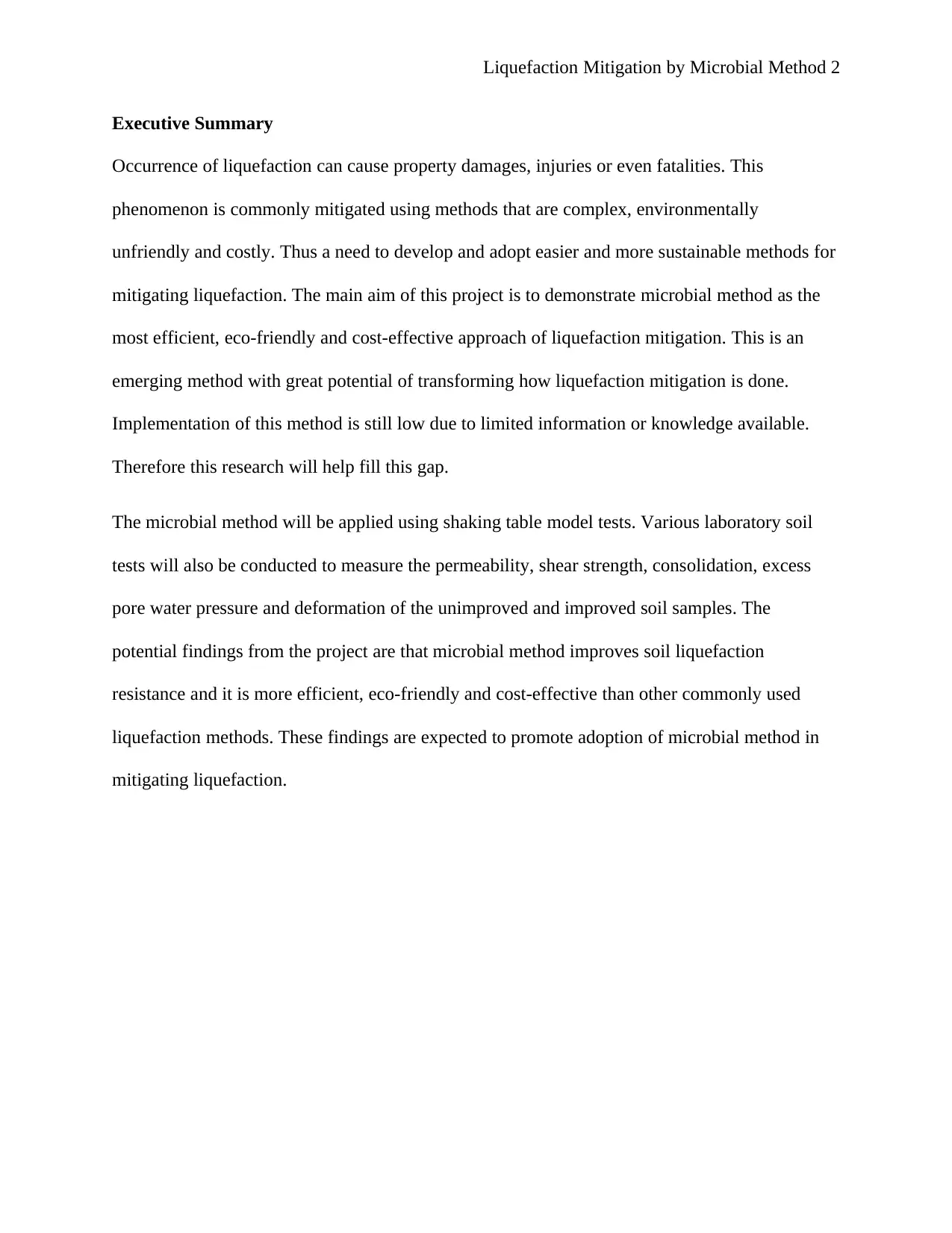
Liquefaction Mitigation by Microbial Method 2
Executive Summary
Occurrence of liquefaction can cause property damages, injuries or even fatalities. This
phenomenon is commonly mitigated using methods that are complex, environmentally
unfriendly and costly. Thus a need to develop and adopt easier and more sustainable methods for
mitigating liquefaction. The main aim of this project is to demonstrate microbial method as the
most efficient, eco-friendly and cost-effective approach of liquefaction mitigation. This is an
emerging method with great potential of transforming how liquefaction mitigation is done.
Implementation of this method is still low due to limited information or knowledge available.
Therefore this research will help fill this gap.
The microbial method will be applied using shaking table model tests. Various laboratory soil
tests will also be conducted to measure the permeability, shear strength, consolidation, excess
pore water pressure and deformation of the unimproved and improved soil samples. The
potential findings from the project are that microbial method improves soil liquefaction
resistance and it is more efficient, eco-friendly and cost-effective than other commonly used
liquefaction methods. These findings are expected to promote adoption of microbial method in
mitigating liquefaction.
Executive Summary
Occurrence of liquefaction can cause property damages, injuries or even fatalities. This
phenomenon is commonly mitigated using methods that are complex, environmentally
unfriendly and costly. Thus a need to develop and adopt easier and more sustainable methods for
mitigating liquefaction. The main aim of this project is to demonstrate microbial method as the
most efficient, eco-friendly and cost-effective approach of liquefaction mitigation. This is an
emerging method with great potential of transforming how liquefaction mitigation is done.
Implementation of this method is still low due to limited information or knowledge available.
Therefore this research will help fill this gap.
The microbial method will be applied using shaking table model tests. Various laboratory soil
tests will also be conducted to measure the permeability, shear strength, consolidation, excess
pore water pressure and deformation of the unimproved and improved soil samples. The
potential findings from the project are that microbial method improves soil liquefaction
resistance and it is more efficient, eco-friendly and cost-effective than other commonly used
liquefaction methods. These findings are expected to promote adoption of microbial method in
mitigating liquefaction.
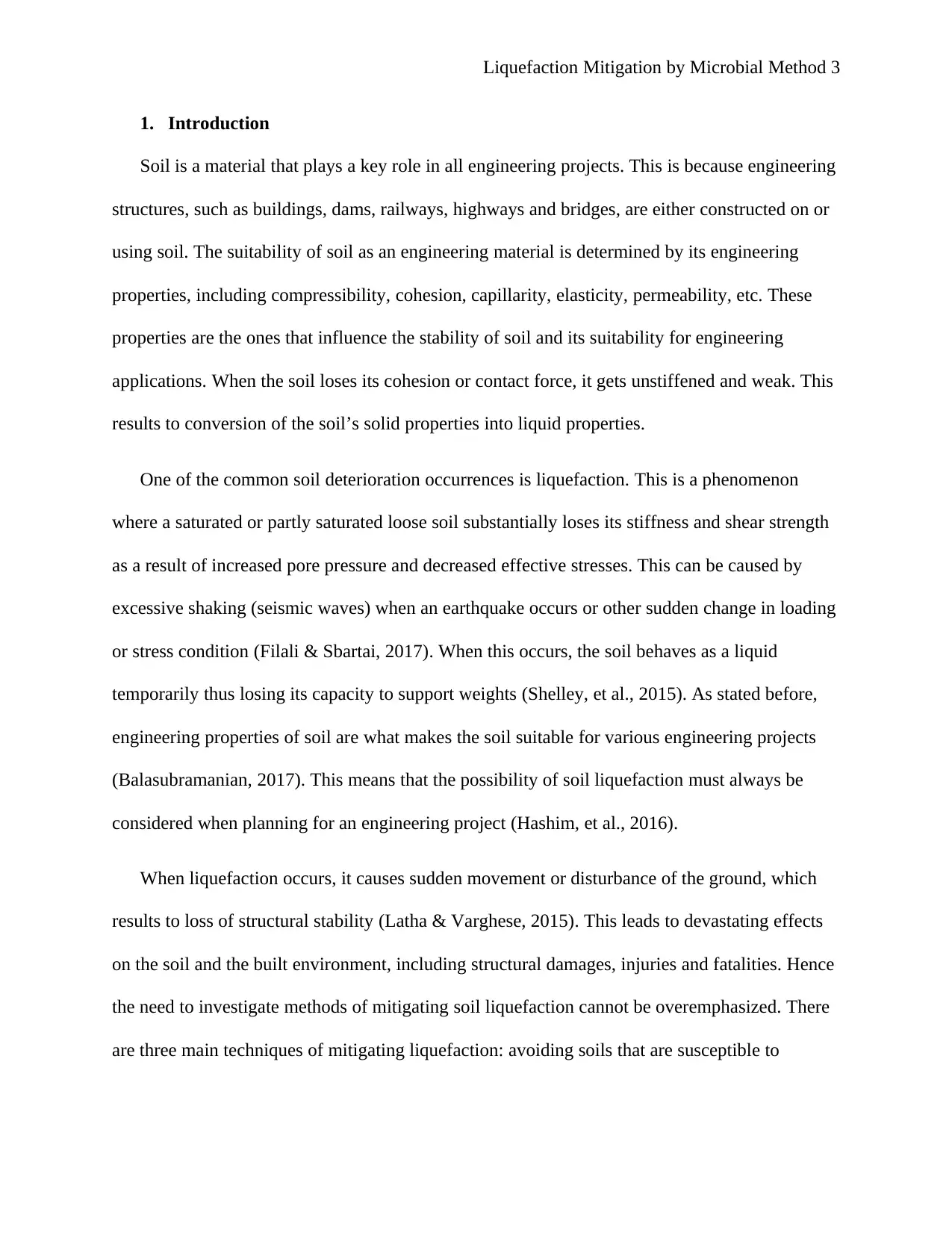
Liquefaction Mitigation by Microbial Method 3
1. Introduction
Soil is a material that plays a key role in all engineering projects. This is because engineering
structures, such as buildings, dams, railways, highways and bridges, are either constructed on or
using soil. The suitability of soil as an engineering material is determined by its engineering
properties, including compressibility, cohesion, capillarity, elasticity, permeability, etc. These
properties are the ones that influence the stability of soil and its suitability for engineering
applications. When the soil loses its cohesion or contact force, it gets unstiffened and weak. This
results to conversion of the soil’s solid properties into liquid properties.
One of the common soil deterioration occurrences is liquefaction. This is a phenomenon
where a saturated or partly saturated loose soil substantially loses its stiffness and shear strength
as a result of increased pore pressure and decreased effective stresses. This can be caused by
excessive shaking (seismic waves) when an earthquake occurs or other sudden change in loading
or stress condition (Filali & Sbartai, 2017). When this occurs, the soil behaves as a liquid
temporarily thus losing its capacity to support weights (Shelley, et al., 2015). As stated before,
engineering properties of soil are what makes the soil suitable for various engineering projects
(Balasubramanian, 2017). This means that the possibility of soil liquefaction must always be
considered when planning for an engineering project (Hashim, et al., 2016).
When liquefaction occurs, it causes sudden movement or disturbance of the ground, which
results to loss of structural stability (Latha & Varghese, 2015). This leads to devastating effects
on the soil and the built environment, including structural damages, injuries and fatalities. Hence
the need to investigate methods of mitigating soil liquefaction cannot be overemphasized. There
are three main techniques of mitigating liquefaction: avoiding soils that are susceptible to
1. Introduction
Soil is a material that plays a key role in all engineering projects. This is because engineering
structures, such as buildings, dams, railways, highways and bridges, are either constructed on or
using soil. The suitability of soil as an engineering material is determined by its engineering
properties, including compressibility, cohesion, capillarity, elasticity, permeability, etc. These
properties are the ones that influence the stability of soil and its suitability for engineering
applications. When the soil loses its cohesion or contact force, it gets unstiffened and weak. This
results to conversion of the soil’s solid properties into liquid properties.
One of the common soil deterioration occurrences is liquefaction. This is a phenomenon
where a saturated or partly saturated loose soil substantially loses its stiffness and shear strength
as a result of increased pore pressure and decreased effective stresses. This can be caused by
excessive shaking (seismic waves) when an earthquake occurs or other sudden change in loading
or stress condition (Filali & Sbartai, 2017). When this occurs, the soil behaves as a liquid
temporarily thus losing its capacity to support weights (Shelley, et al., 2015). As stated before,
engineering properties of soil are what makes the soil suitable for various engineering projects
(Balasubramanian, 2017). This means that the possibility of soil liquefaction must always be
considered when planning for an engineering project (Hashim, et al., 2016).
When liquefaction occurs, it causes sudden movement or disturbance of the ground, which
results to loss of structural stability (Latha & Varghese, 2015). This leads to devastating effects
on the soil and the built environment, including structural damages, injuries and fatalities. Hence
the need to investigate methods of mitigating soil liquefaction cannot be overemphasized. There
are three main techniques of mitigating liquefaction: avoiding soils that are susceptible to
⊘ This is a preview!⊘
Do you want full access?
Subscribe today to unlock all pages.

Trusted by 1+ million students worldwide
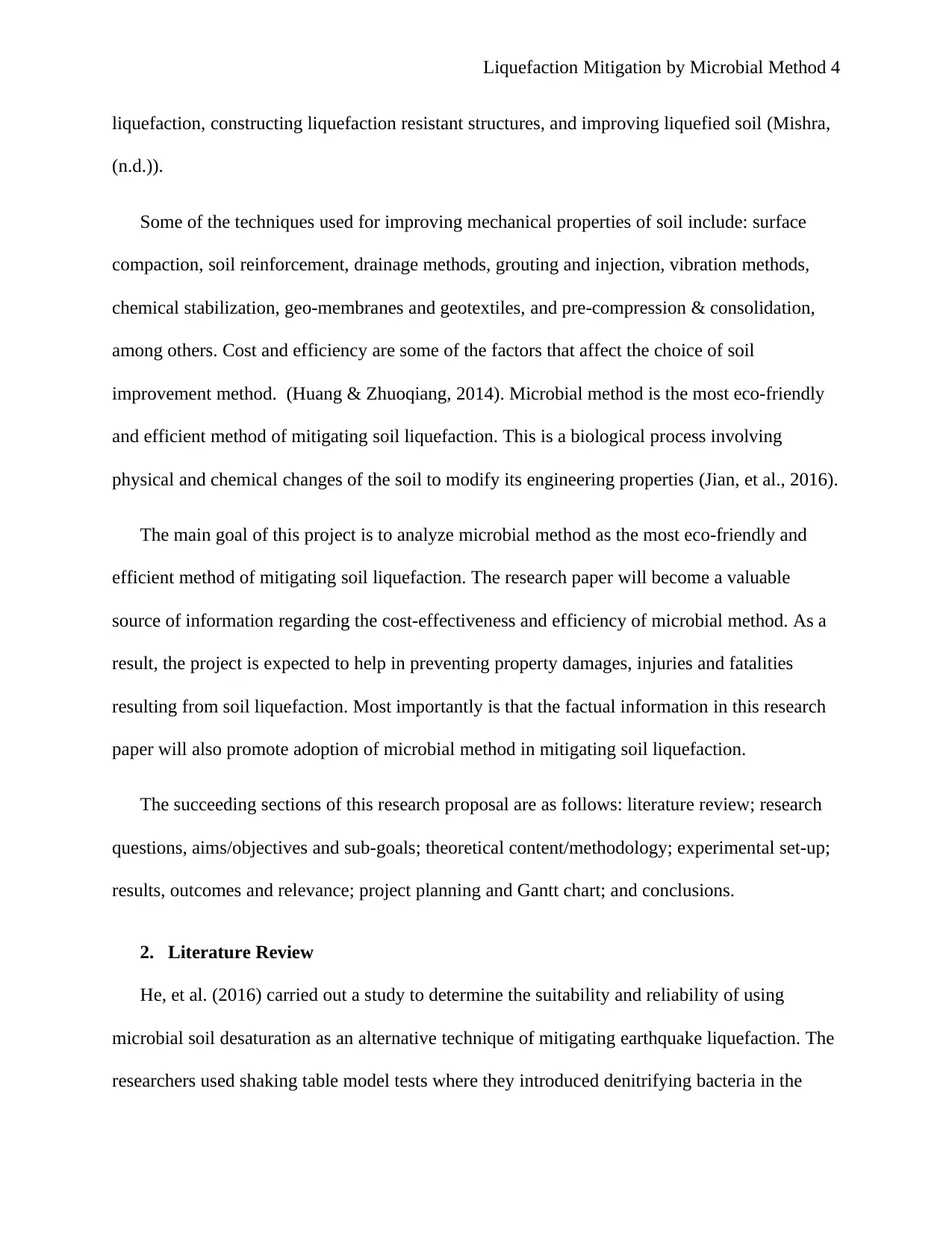
Liquefaction Mitigation by Microbial Method 4
liquefaction, constructing liquefaction resistant structures, and improving liquefied soil (Mishra,
(n.d.)).
Some of the techniques used for improving mechanical properties of soil include: surface
compaction, soil reinforcement, drainage methods, grouting and injection, vibration methods,
chemical stabilization, geo-membranes and geotextiles, and pre-compression & consolidation,
among others. Cost and efficiency are some of the factors that affect the choice of soil
improvement method. (Huang & Zhuoqiang, 2014). Microbial method is the most eco-friendly
and efficient method of mitigating soil liquefaction. This is a biological process involving
physical and chemical changes of the soil to modify its engineering properties (Jian, et al., 2016).
The main goal of this project is to analyze microbial method as the most eco-friendly and
efficient method of mitigating soil liquefaction. The research paper will become a valuable
source of information regarding the cost-effectiveness and efficiency of microbial method. As a
result, the project is expected to help in preventing property damages, injuries and fatalities
resulting from soil liquefaction. Most importantly is that the factual information in this research
paper will also promote adoption of microbial method in mitigating soil liquefaction.
The succeeding sections of this research proposal are as follows: literature review; research
questions, aims/objectives and sub-goals; theoretical content/methodology; experimental set-up;
results, outcomes and relevance; project planning and Gantt chart; and conclusions.
2. Literature Review
He, et al. (2016) carried out a study to determine the suitability and reliability of using
microbial soil desaturation as an alternative technique of mitigating earthquake liquefaction. The
researchers used shaking table model tests where they introduced denitrifying bacteria in the
liquefaction, constructing liquefaction resistant structures, and improving liquefied soil (Mishra,
(n.d.)).
Some of the techniques used for improving mechanical properties of soil include: surface
compaction, soil reinforcement, drainage methods, grouting and injection, vibration methods,
chemical stabilization, geo-membranes and geotextiles, and pre-compression & consolidation,
among others. Cost and efficiency are some of the factors that affect the choice of soil
improvement method. (Huang & Zhuoqiang, 2014). Microbial method is the most eco-friendly
and efficient method of mitigating soil liquefaction. This is a biological process involving
physical and chemical changes of the soil to modify its engineering properties (Jian, et al., 2016).
The main goal of this project is to analyze microbial method as the most eco-friendly and
efficient method of mitigating soil liquefaction. The research paper will become a valuable
source of information regarding the cost-effectiveness and efficiency of microbial method. As a
result, the project is expected to help in preventing property damages, injuries and fatalities
resulting from soil liquefaction. Most importantly is that the factual information in this research
paper will also promote adoption of microbial method in mitigating soil liquefaction.
The succeeding sections of this research proposal are as follows: literature review; research
questions, aims/objectives and sub-goals; theoretical content/methodology; experimental set-up;
results, outcomes and relevance; project planning and Gantt chart; and conclusions.
2. Literature Review
He, et al. (2016) carried out a study to determine the suitability and reliability of using
microbial soil desaturation as an alternative technique of mitigating earthquake liquefaction. The
researchers used shaking table model tests where they introduced denitrifying bacteria in the
Paraphrase This Document
Need a fresh take? Get an instant paraphrase of this document with our AI Paraphraser
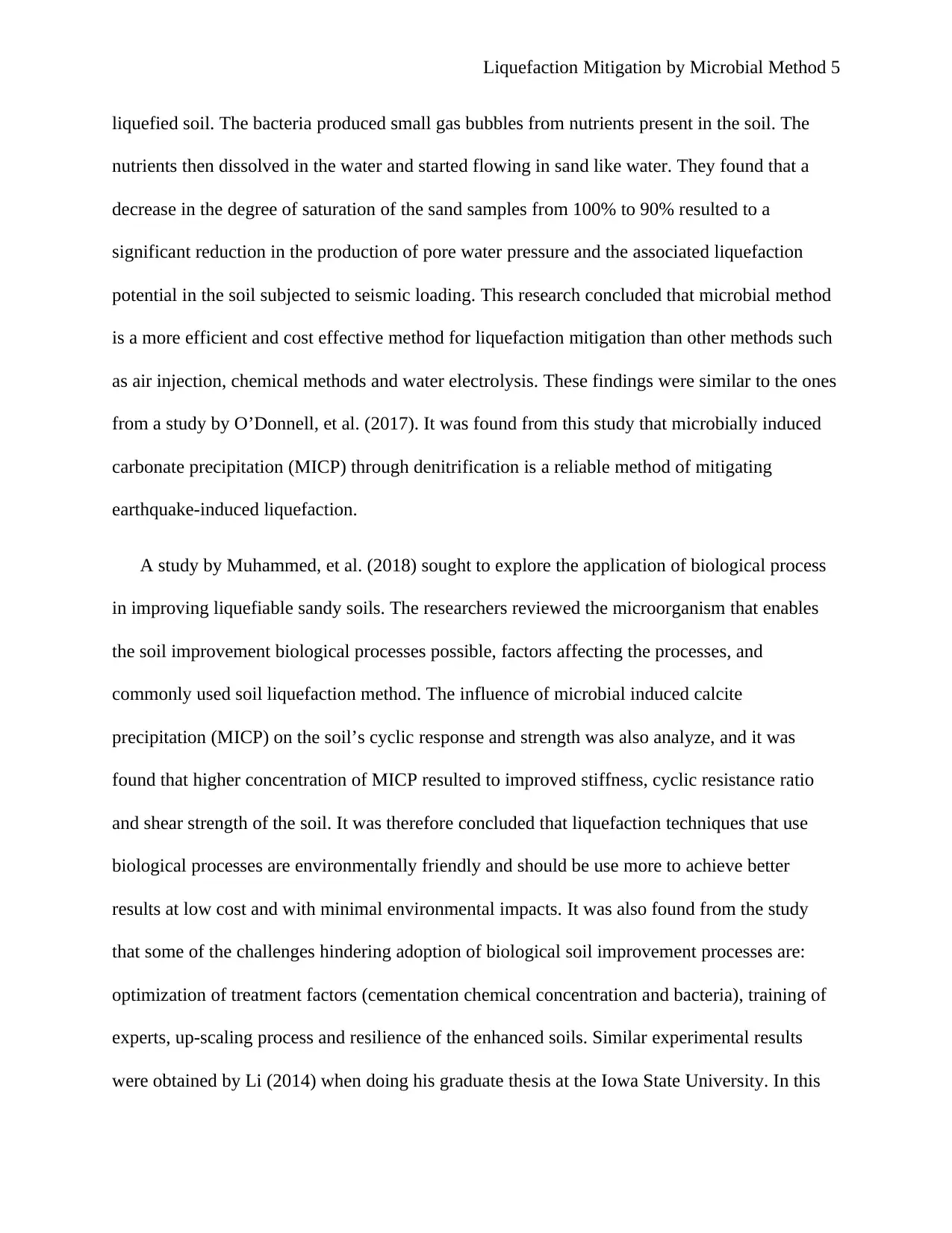
Liquefaction Mitigation by Microbial Method 5
liquefied soil. The bacteria produced small gas bubbles from nutrients present in the soil. The
nutrients then dissolved in the water and started flowing in sand like water. They found that a
decrease in the degree of saturation of the sand samples from 100% to 90% resulted to a
significant reduction in the production of pore water pressure and the associated liquefaction
potential in the soil subjected to seismic loading. This research concluded that microbial method
is a more efficient and cost effective method for liquefaction mitigation than other methods such
as air injection, chemical methods and water electrolysis. These findings were similar to the ones
from a study by O’Donnell, et al. (2017). It was found from this study that microbially induced
carbonate precipitation (MICP) through denitrification is a reliable method of mitigating
earthquake-induced liquefaction.
A study by Muhammed, et al. (2018) sought to explore the application of biological process
in improving liquefiable sandy soils. The researchers reviewed the microorganism that enables
the soil improvement biological processes possible, factors affecting the processes, and
commonly used soil liquefaction method. The influence of microbial induced calcite
precipitation (MICP) on the soil’s cyclic response and strength was also analyze, and it was
found that higher concentration of MICP resulted to improved stiffness, cyclic resistance ratio
and shear strength of the soil. It was therefore concluded that liquefaction techniques that use
biological processes are environmentally friendly and should be use more to achieve better
results at low cost and with minimal environmental impacts. It was also found from the study
that some of the challenges hindering adoption of biological soil improvement processes are:
optimization of treatment factors (cementation chemical concentration and bacteria), training of
experts, up-scaling process and resilience of the enhanced soils. Similar experimental results
were obtained by Li (2014) when doing his graduate thesis at the Iowa State University. In this
liquefied soil. The bacteria produced small gas bubbles from nutrients present in the soil. The
nutrients then dissolved in the water and started flowing in sand like water. They found that a
decrease in the degree of saturation of the sand samples from 100% to 90% resulted to a
significant reduction in the production of pore water pressure and the associated liquefaction
potential in the soil subjected to seismic loading. This research concluded that microbial method
is a more efficient and cost effective method for liquefaction mitigation than other methods such
as air injection, chemical methods and water electrolysis. These findings were similar to the ones
from a study by O’Donnell, et al. (2017). It was found from this study that microbially induced
carbonate precipitation (MICP) through denitrification is a reliable method of mitigating
earthquake-induced liquefaction.
A study by Muhammed, et al. (2018) sought to explore the application of biological process
in improving liquefiable sandy soils. The researchers reviewed the microorganism that enables
the soil improvement biological processes possible, factors affecting the processes, and
commonly used soil liquefaction method. The influence of microbial induced calcite
precipitation (MICP) on the soil’s cyclic response and strength was also analyze, and it was
found that higher concentration of MICP resulted to improved stiffness, cyclic resistance ratio
and shear strength of the soil. It was therefore concluded that liquefaction techniques that use
biological processes are environmentally friendly and should be use more to achieve better
results at low cost and with minimal environmental impacts. It was also found from the study
that some of the challenges hindering adoption of biological soil improvement processes are:
optimization of treatment factors (cementation chemical concentration and bacteria), training of
experts, up-scaling process and resilience of the enhanced soils. Similar experimental results
were obtained by Li (2014) when doing his graduate thesis at the Iowa State University. In this
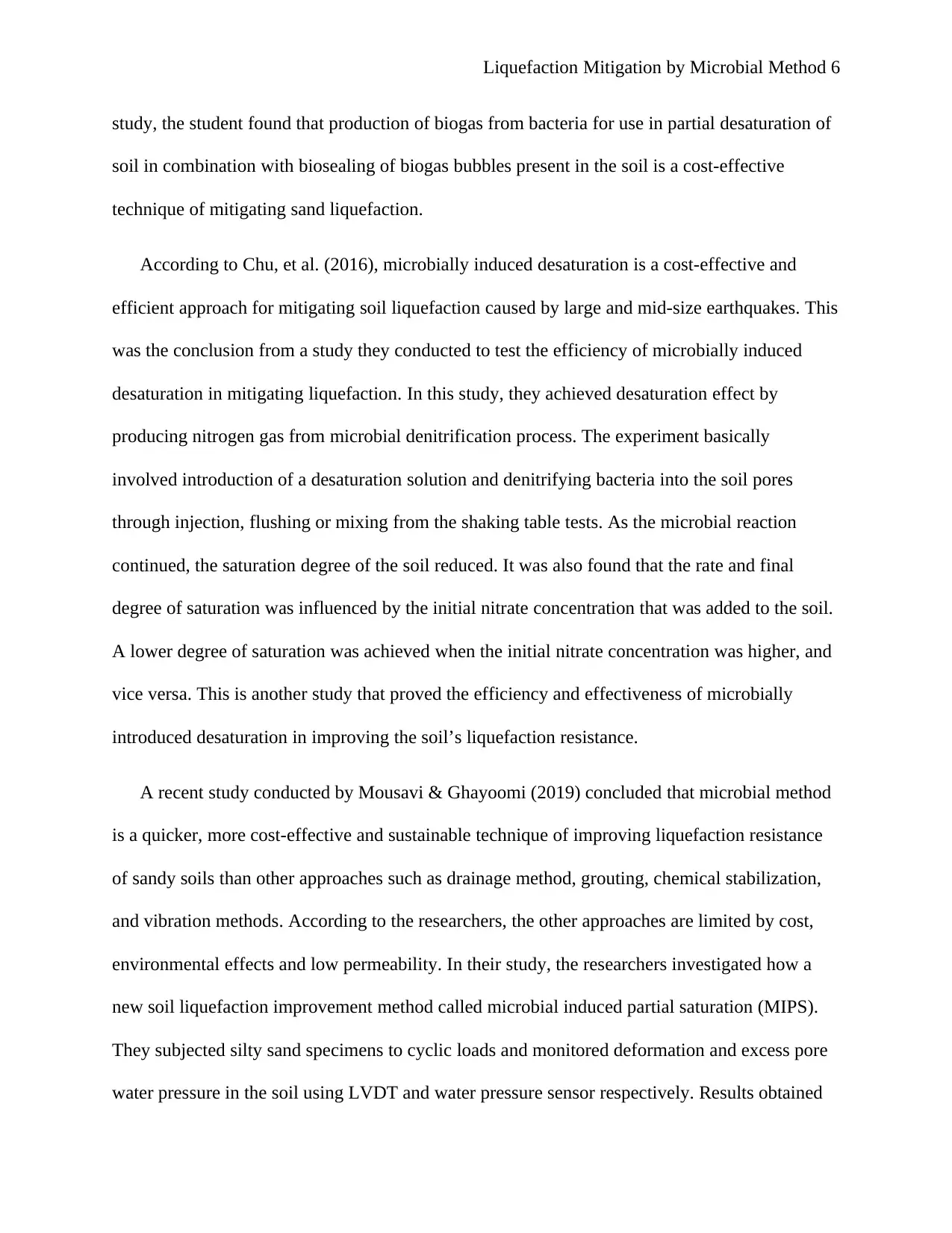
Liquefaction Mitigation by Microbial Method 6
study, the student found that production of biogas from bacteria for use in partial desaturation of
soil in combination with biosealing of biogas bubbles present in the soil is a cost-effective
technique of mitigating sand liquefaction.
According to Chu, et al. (2016), microbially induced desaturation is a cost-effective and
efficient approach for mitigating soil liquefaction caused by large and mid-size earthquakes. This
was the conclusion from a study they conducted to test the efficiency of microbially induced
desaturation in mitigating liquefaction. In this study, they achieved desaturation effect by
producing nitrogen gas from microbial denitrification process. The experiment basically
involved introduction of a desaturation solution and denitrifying bacteria into the soil pores
through injection, flushing or mixing from the shaking table tests. As the microbial reaction
continued, the saturation degree of the soil reduced. It was also found that the rate and final
degree of saturation was influenced by the initial nitrate concentration that was added to the soil.
A lower degree of saturation was achieved when the initial nitrate concentration was higher, and
vice versa. This is another study that proved the efficiency and effectiveness of microbially
introduced desaturation in improving the soil’s liquefaction resistance.
A recent study conducted by Mousavi & Ghayoomi (2019) concluded that microbial method
is a quicker, more cost-effective and sustainable technique of improving liquefaction resistance
of sandy soils than other approaches such as drainage method, grouting, chemical stabilization,
and vibration methods. According to the researchers, the other approaches are limited by cost,
environmental effects and low permeability. In their study, the researchers investigated how a
new soil liquefaction improvement method called microbial induced partial saturation (MIPS).
They subjected silty sand specimens to cyclic loads and monitored deformation and excess pore
water pressure in the soil using LVDT and water pressure sensor respectively. Results obtained
study, the student found that production of biogas from bacteria for use in partial desaturation of
soil in combination with biosealing of biogas bubbles present in the soil is a cost-effective
technique of mitigating sand liquefaction.
According to Chu, et al. (2016), microbially induced desaturation is a cost-effective and
efficient approach for mitigating soil liquefaction caused by large and mid-size earthquakes. This
was the conclusion from a study they conducted to test the efficiency of microbially induced
desaturation in mitigating liquefaction. In this study, they achieved desaturation effect by
producing nitrogen gas from microbial denitrification process. The experiment basically
involved introduction of a desaturation solution and denitrifying bacteria into the soil pores
through injection, flushing or mixing from the shaking table tests. As the microbial reaction
continued, the saturation degree of the soil reduced. It was also found that the rate and final
degree of saturation was influenced by the initial nitrate concentration that was added to the soil.
A lower degree of saturation was achieved when the initial nitrate concentration was higher, and
vice versa. This is another study that proved the efficiency and effectiveness of microbially
introduced desaturation in improving the soil’s liquefaction resistance.
A recent study conducted by Mousavi & Ghayoomi (2019) concluded that microbial method
is a quicker, more cost-effective and sustainable technique of improving liquefaction resistance
of sandy soils than other approaches such as drainage method, grouting, chemical stabilization,
and vibration methods. According to the researchers, the other approaches are limited by cost,
environmental effects and low permeability. In their study, the researchers investigated how a
new soil liquefaction improvement method called microbial induced partial saturation (MIPS).
They subjected silty sand specimens to cyclic loads and monitored deformation and excess pore
water pressure in the soil using LVDT and water pressure sensor respectively. Results obtained
⊘ This is a preview!⊘
Do you want full access?
Subscribe today to unlock all pages.

Trusted by 1+ million students worldwide
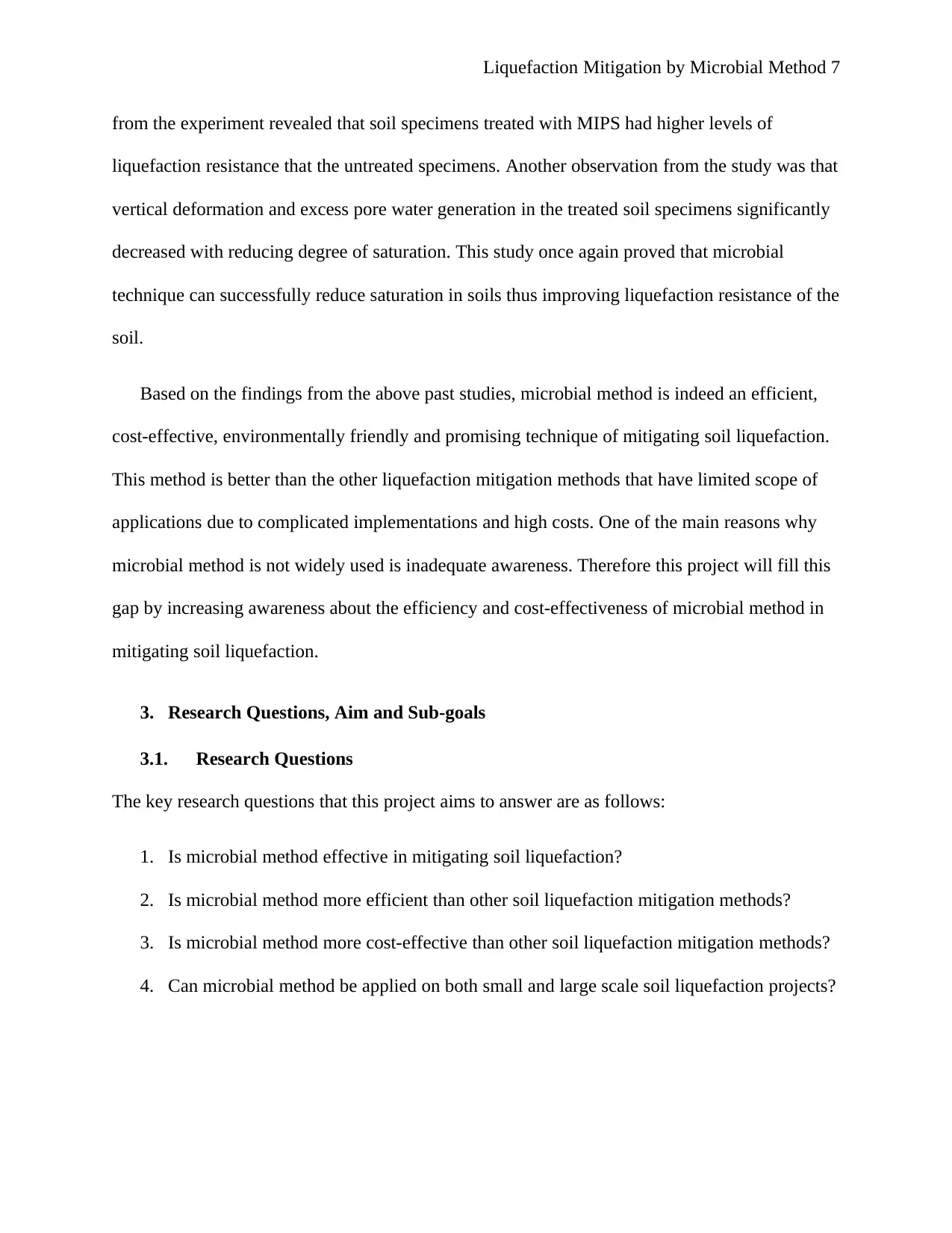
Liquefaction Mitigation by Microbial Method 7
from the experiment revealed that soil specimens treated with MIPS had higher levels of
liquefaction resistance that the untreated specimens. Another observation from the study was that
vertical deformation and excess pore water generation in the treated soil specimens significantly
decreased with reducing degree of saturation. This study once again proved that microbial
technique can successfully reduce saturation in soils thus improving liquefaction resistance of the
soil.
Based on the findings from the above past studies, microbial method is indeed an efficient,
cost-effective, environmentally friendly and promising technique of mitigating soil liquefaction.
This method is better than the other liquefaction mitigation methods that have limited scope of
applications due to complicated implementations and high costs. One of the main reasons why
microbial method is not widely used is inadequate awareness. Therefore this project will fill this
gap by increasing awareness about the efficiency and cost-effectiveness of microbial method in
mitigating soil liquefaction.
3. Research Questions, Aim and Sub-goals
3.1. Research Questions
The key research questions that this project aims to answer are as follows:
1. Is microbial method effective in mitigating soil liquefaction?
2. Is microbial method more efficient than other soil liquefaction mitigation methods?
3. Is microbial method more cost-effective than other soil liquefaction mitigation methods?
4. Can microbial method be applied on both small and large scale soil liquefaction projects?
from the experiment revealed that soil specimens treated with MIPS had higher levels of
liquefaction resistance that the untreated specimens. Another observation from the study was that
vertical deformation and excess pore water generation in the treated soil specimens significantly
decreased with reducing degree of saturation. This study once again proved that microbial
technique can successfully reduce saturation in soils thus improving liquefaction resistance of the
soil.
Based on the findings from the above past studies, microbial method is indeed an efficient,
cost-effective, environmentally friendly and promising technique of mitigating soil liquefaction.
This method is better than the other liquefaction mitigation methods that have limited scope of
applications due to complicated implementations and high costs. One of the main reasons why
microbial method is not widely used is inadequate awareness. Therefore this project will fill this
gap by increasing awareness about the efficiency and cost-effectiveness of microbial method in
mitigating soil liquefaction.
3. Research Questions, Aim and Sub-goals
3.1. Research Questions
The key research questions that this project aims to answer are as follows:
1. Is microbial method effective in mitigating soil liquefaction?
2. Is microbial method more efficient than other soil liquefaction mitigation methods?
3. Is microbial method more cost-effective than other soil liquefaction mitigation methods?
4. Can microbial method be applied on both small and large scale soil liquefaction projects?
Paraphrase This Document
Need a fresh take? Get an instant paraphrase of this document with our AI Paraphraser
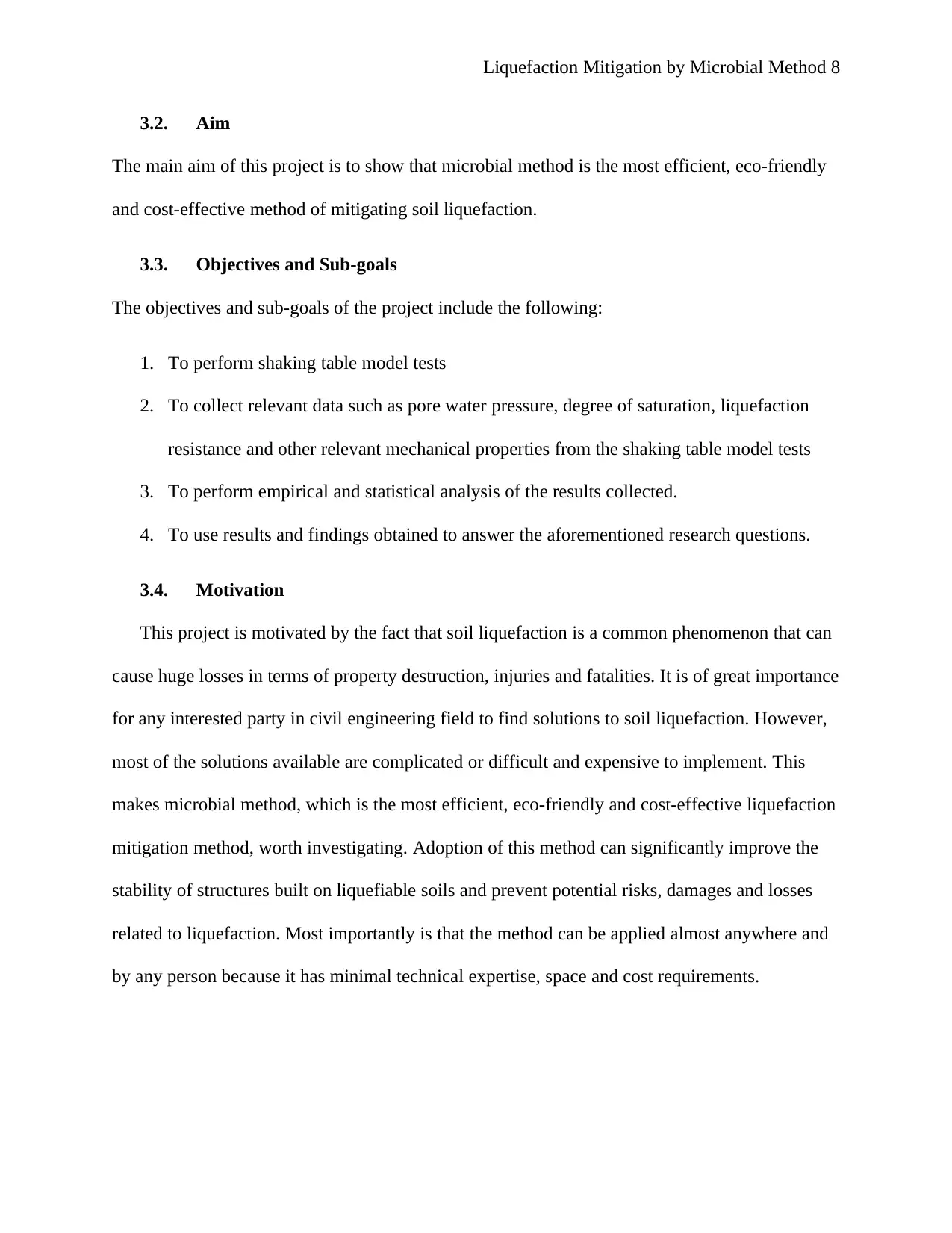
Liquefaction Mitigation by Microbial Method 8
3.2. Aim
The main aim of this project is to show that microbial method is the most efficient, eco-friendly
and cost-effective method of mitigating soil liquefaction.
3.3. Objectives and Sub-goals
The objectives and sub-goals of the project include the following:
1. To perform shaking table model tests
2. To collect relevant data such as pore water pressure, degree of saturation, liquefaction
resistance and other relevant mechanical properties from the shaking table model tests
3. To perform empirical and statistical analysis of the results collected.
4. To use results and findings obtained to answer the aforementioned research questions.
3.4. Motivation
This project is motivated by the fact that soil liquefaction is a common phenomenon that can
cause huge losses in terms of property destruction, injuries and fatalities. It is of great importance
for any interested party in civil engineering field to find solutions to soil liquefaction. However,
most of the solutions available are complicated or difficult and expensive to implement. This
makes microbial method, which is the most efficient, eco-friendly and cost-effective liquefaction
mitigation method, worth investigating. Adoption of this method can significantly improve the
stability of structures built on liquefiable soils and prevent potential risks, damages and losses
related to liquefaction. Most importantly is that the method can be applied almost anywhere and
by any person because it has minimal technical expertise, space and cost requirements.
3.2. Aim
The main aim of this project is to show that microbial method is the most efficient, eco-friendly
and cost-effective method of mitigating soil liquefaction.
3.3. Objectives and Sub-goals
The objectives and sub-goals of the project include the following:
1. To perform shaking table model tests
2. To collect relevant data such as pore water pressure, degree of saturation, liquefaction
resistance and other relevant mechanical properties from the shaking table model tests
3. To perform empirical and statistical analysis of the results collected.
4. To use results and findings obtained to answer the aforementioned research questions.
3.4. Motivation
This project is motivated by the fact that soil liquefaction is a common phenomenon that can
cause huge losses in terms of property destruction, injuries and fatalities. It is of great importance
for any interested party in civil engineering field to find solutions to soil liquefaction. However,
most of the solutions available are complicated or difficult and expensive to implement. This
makes microbial method, which is the most efficient, eco-friendly and cost-effective liquefaction
mitigation method, worth investigating. Adoption of this method can significantly improve the
stability of structures built on liquefiable soils and prevent potential risks, damages and losses
related to liquefaction. Most importantly is that the method can be applied almost anywhere and
by any person because it has minimal technical expertise, space and cost requirements.
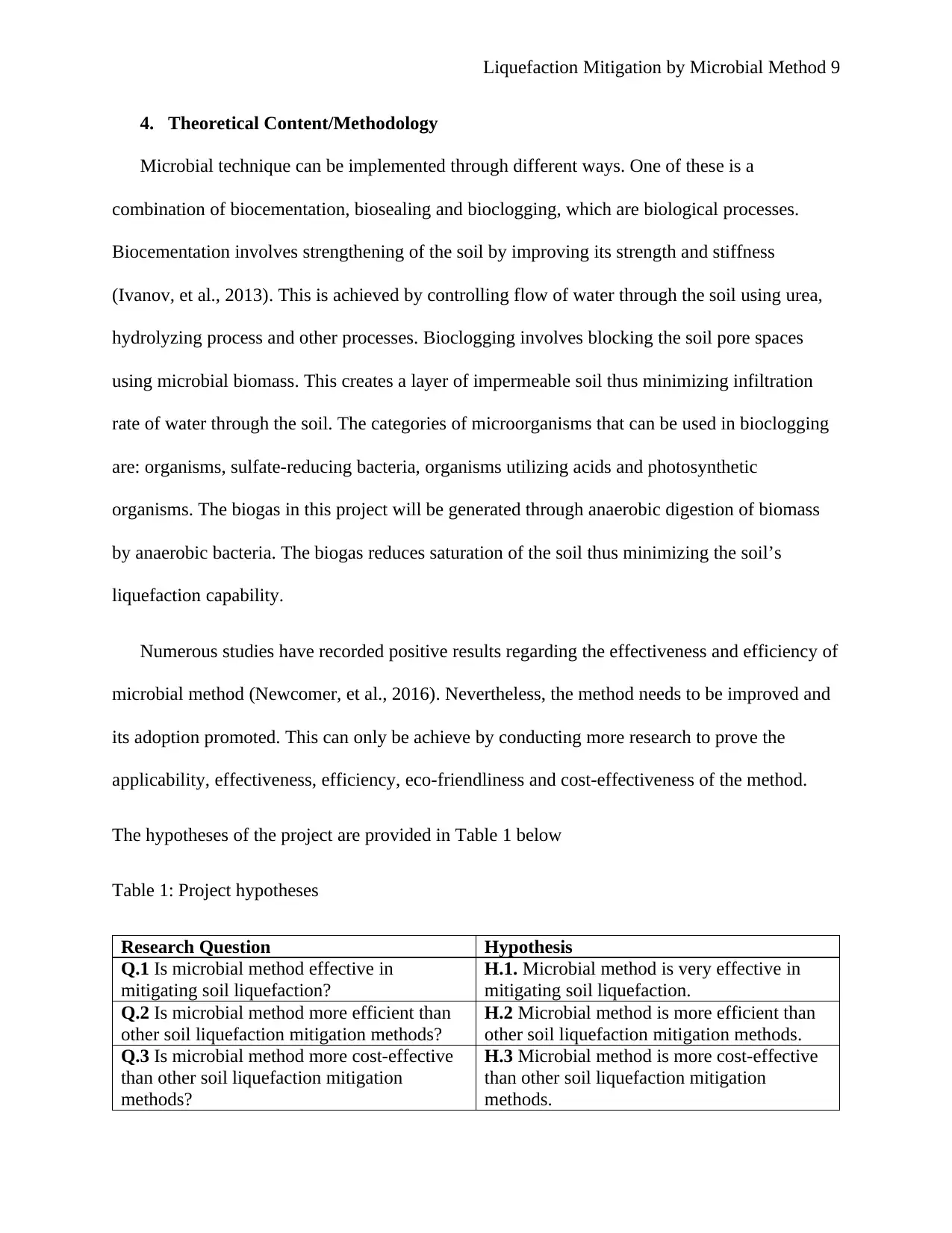
Liquefaction Mitigation by Microbial Method 9
4. Theoretical Content/Methodology
Microbial technique can be implemented through different ways. One of these is a
combination of biocementation, biosealing and bioclogging, which are biological processes.
Biocementation involves strengthening of the soil by improving its strength and stiffness
(Ivanov, et al., 2013). This is achieved by controlling flow of water through the soil using urea,
hydrolyzing process and other processes. Bioclogging involves blocking the soil pore spaces
using microbial biomass. This creates a layer of impermeable soil thus minimizing infiltration
rate of water through the soil. The categories of microorganisms that can be used in bioclogging
are: organisms, sulfate-reducing bacteria, organisms utilizing acids and photosynthetic
organisms. The biogas in this project will be generated through anaerobic digestion of biomass
by anaerobic bacteria. The biogas reduces saturation of the soil thus minimizing the soil’s
liquefaction capability.
Numerous studies have recorded positive results regarding the effectiveness and efficiency of
microbial method (Newcomer, et al., 2016). Nevertheless, the method needs to be improved and
its adoption promoted. This can only be achieve by conducting more research to prove the
applicability, effectiveness, efficiency, eco-friendliness and cost-effectiveness of the method.
The hypotheses of the project are provided in Table 1 below
Table 1: Project hypotheses
Research Question Hypothesis
Q.1 Is microbial method effective in
mitigating soil liquefaction?
H.1. Microbial method is very effective in
mitigating soil liquefaction.
Q.2 Is microbial method more efficient than
other soil liquefaction mitigation methods?
H.2 Microbial method is more efficient than
other soil liquefaction mitigation methods.
Q.3 Is microbial method more cost-effective
than other soil liquefaction mitigation
methods?
H.3 Microbial method is more cost-effective
than other soil liquefaction mitigation
methods.
4. Theoretical Content/Methodology
Microbial technique can be implemented through different ways. One of these is a
combination of biocementation, biosealing and bioclogging, which are biological processes.
Biocementation involves strengthening of the soil by improving its strength and stiffness
(Ivanov, et al., 2013). This is achieved by controlling flow of water through the soil using urea,
hydrolyzing process and other processes. Bioclogging involves blocking the soil pore spaces
using microbial biomass. This creates a layer of impermeable soil thus minimizing infiltration
rate of water through the soil. The categories of microorganisms that can be used in bioclogging
are: organisms, sulfate-reducing bacteria, organisms utilizing acids and photosynthetic
organisms. The biogas in this project will be generated through anaerobic digestion of biomass
by anaerobic bacteria. The biogas reduces saturation of the soil thus minimizing the soil’s
liquefaction capability.
Numerous studies have recorded positive results regarding the effectiveness and efficiency of
microbial method (Newcomer, et al., 2016). Nevertheless, the method needs to be improved and
its adoption promoted. This can only be achieve by conducting more research to prove the
applicability, effectiveness, efficiency, eco-friendliness and cost-effectiveness of the method.
The hypotheses of the project are provided in Table 1 below
Table 1: Project hypotheses
Research Question Hypothesis
Q.1 Is microbial method effective in
mitigating soil liquefaction?
H.1. Microbial method is very effective in
mitigating soil liquefaction.
Q.2 Is microbial method more efficient than
other soil liquefaction mitigation methods?
H.2 Microbial method is more efficient than
other soil liquefaction mitigation methods.
Q.3 Is microbial method more cost-effective
than other soil liquefaction mitigation
methods?
H.3 Microbial method is more cost-effective
than other soil liquefaction mitigation
methods.
⊘ This is a preview!⊘
Do you want full access?
Subscribe today to unlock all pages.

Trusted by 1+ million students worldwide
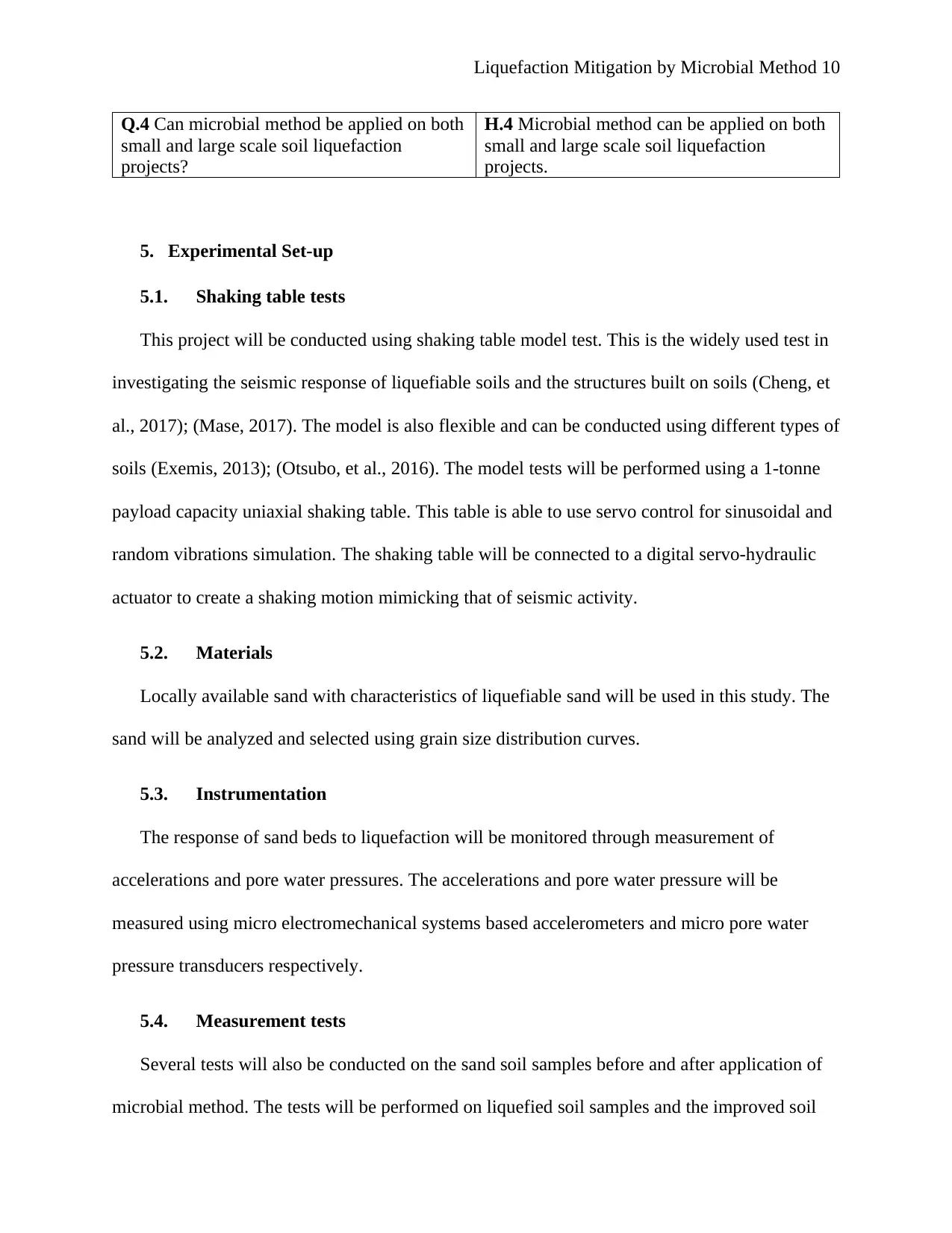
Liquefaction Mitigation by Microbial Method 10
Q.4 Can microbial method be applied on both
small and large scale soil liquefaction
projects?
H.4 Microbial method can be applied on both
small and large scale soil liquefaction
projects.
5. Experimental Set-up
5.1. Shaking table tests
This project will be conducted using shaking table model test. This is the widely used test in
investigating the seismic response of liquefiable soils and the structures built on soils (Cheng, et
al., 2017); (Mase, 2017). The model is also flexible and can be conducted using different types of
soils (Exemis, 2013); (Otsubo, et al., 2016). The model tests will be performed using a 1-tonne
payload capacity uniaxial shaking table. This table is able to use servo control for sinusoidal and
random vibrations simulation. The shaking table will be connected to a digital servo-hydraulic
actuator to create a shaking motion mimicking that of seismic activity.
5.2. Materials
Locally available sand with characteristics of liquefiable sand will be used in this study. The
sand will be analyzed and selected using grain size distribution curves.
5.3. Instrumentation
The response of sand beds to liquefaction will be monitored through measurement of
accelerations and pore water pressures. The accelerations and pore water pressure will be
measured using micro electromechanical systems based accelerometers and micro pore water
pressure transducers respectively.
5.4. Measurement tests
Several tests will also be conducted on the sand soil samples before and after application of
microbial method. The tests will be performed on liquefied soil samples and the improved soil
Q.4 Can microbial method be applied on both
small and large scale soil liquefaction
projects?
H.4 Microbial method can be applied on both
small and large scale soil liquefaction
projects.
5. Experimental Set-up
5.1. Shaking table tests
This project will be conducted using shaking table model test. This is the widely used test in
investigating the seismic response of liquefiable soils and the structures built on soils (Cheng, et
al., 2017); (Mase, 2017). The model is also flexible and can be conducted using different types of
soils (Exemis, 2013); (Otsubo, et al., 2016). The model tests will be performed using a 1-tonne
payload capacity uniaxial shaking table. This table is able to use servo control for sinusoidal and
random vibrations simulation. The shaking table will be connected to a digital servo-hydraulic
actuator to create a shaking motion mimicking that of seismic activity.
5.2. Materials
Locally available sand with characteristics of liquefiable sand will be used in this study. The
sand will be analyzed and selected using grain size distribution curves.
5.3. Instrumentation
The response of sand beds to liquefaction will be monitored through measurement of
accelerations and pore water pressures. The accelerations and pore water pressure will be
measured using micro electromechanical systems based accelerometers and micro pore water
pressure transducers respectively.
5.4. Measurement tests
Several tests will also be conducted on the sand soil samples before and after application of
microbial method. The tests will be performed on liquefied soil samples and the improved soil
Paraphrase This Document
Need a fresh take? Get an instant paraphrase of this document with our AI Paraphraser
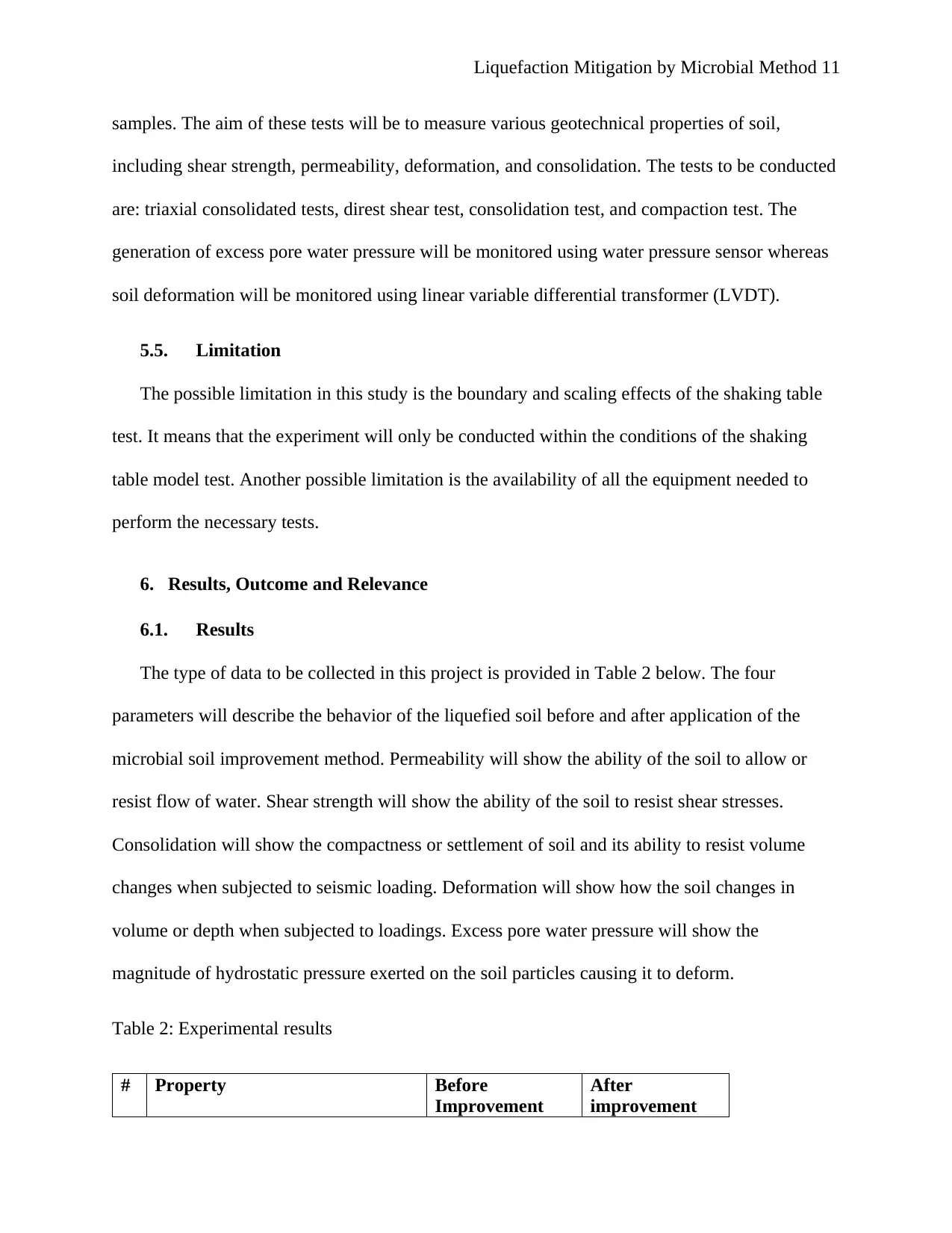
Liquefaction Mitigation by Microbial Method 11
samples. The aim of these tests will be to measure various geotechnical properties of soil,
including shear strength, permeability, deformation, and consolidation. The tests to be conducted
are: triaxial consolidated tests, direst shear test, consolidation test, and compaction test. The
generation of excess pore water pressure will be monitored using water pressure sensor whereas
soil deformation will be monitored using linear variable differential transformer (LVDT).
5.5. Limitation
The possible limitation in this study is the boundary and scaling effects of the shaking table
test. It means that the experiment will only be conducted within the conditions of the shaking
table model test. Another possible limitation is the availability of all the equipment needed to
perform the necessary tests.
6. Results, Outcome and Relevance
6.1. Results
The type of data to be collected in this project is provided in Table 2 below. The four
parameters will describe the behavior of the liquefied soil before and after application of the
microbial soil improvement method. Permeability will show the ability of the soil to allow or
resist flow of water. Shear strength will show the ability of the soil to resist shear stresses.
Consolidation will show the compactness or settlement of soil and its ability to resist volume
changes when subjected to seismic loading. Deformation will show how the soil changes in
volume or depth when subjected to loadings. Excess pore water pressure will show the
magnitude of hydrostatic pressure exerted on the soil particles causing it to deform.
Table 2: Experimental results
# Property Before
Improvement
After
improvement
samples. The aim of these tests will be to measure various geotechnical properties of soil,
including shear strength, permeability, deformation, and consolidation. The tests to be conducted
are: triaxial consolidated tests, direst shear test, consolidation test, and compaction test. The
generation of excess pore water pressure will be monitored using water pressure sensor whereas
soil deformation will be monitored using linear variable differential transformer (LVDT).
5.5. Limitation
The possible limitation in this study is the boundary and scaling effects of the shaking table
test. It means that the experiment will only be conducted within the conditions of the shaking
table model test. Another possible limitation is the availability of all the equipment needed to
perform the necessary tests.
6. Results, Outcome and Relevance
6.1. Results
The type of data to be collected in this project is provided in Table 2 below. The four
parameters will describe the behavior of the liquefied soil before and after application of the
microbial soil improvement method. Permeability will show the ability of the soil to allow or
resist flow of water. Shear strength will show the ability of the soil to resist shear stresses.
Consolidation will show the compactness or settlement of soil and its ability to resist volume
changes when subjected to seismic loading. Deformation will show how the soil changes in
volume or depth when subjected to loadings. Excess pore water pressure will show the
magnitude of hydrostatic pressure exerted on the soil particles causing it to deform.
Table 2: Experimental results
# Property Before
Improvement
After
improvement
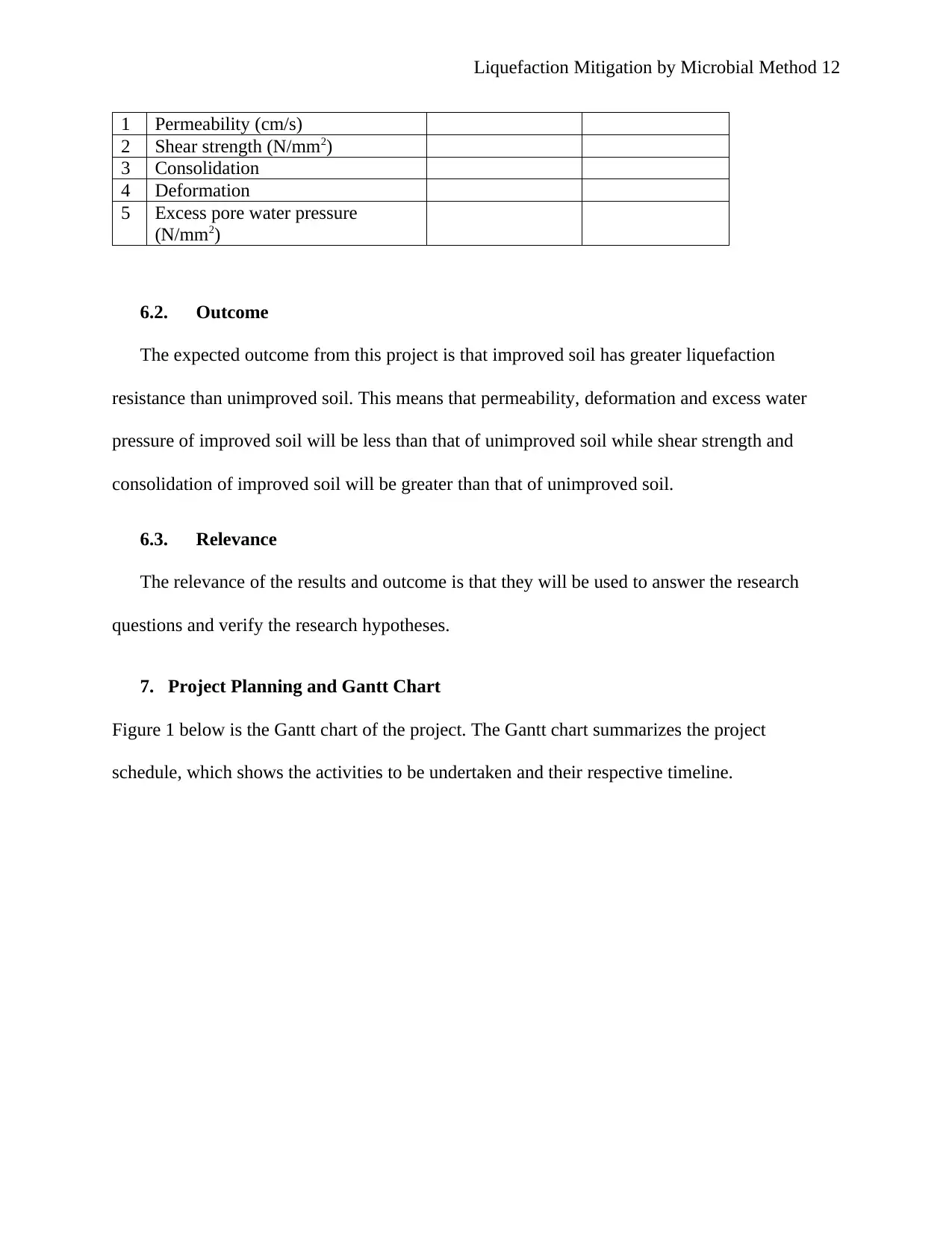
Liquefaction Mitigation by Microbial Method 12
1 Permeability (cm/s)
2 Shear strength (N/mm2)
3 Consolidation
4 Deformation
5 Excess pore water pressure
(N/mm2)
6.2. Outcome
The expected outcome from this project is that improved soil has greater liquefaction
resistance than unimproved soil. This means that permeability, deformation and excess water
pressure of improved soil will be less than that of unimproved soil while shear strength and
consolidation of improved soil will be greater than that of unimproved soil.
6.3. Relevance
The relevance of the results and outcome is that they will be used to answer the research
questions and verify the research hypotheses.
7. Project Planning and Gantt Chart
Figure 1 below is the Gantt chart of the project. The Gantt chart summarizes the project
schedule, which shows the activities to be undertaken and their respective timeline.
1 Permeability (cm/s)
2 Shear strength (N/mm2)
3 Consolidation
4 Deformation
5 Excess pore water pressure
(N/mm2)
6.2. Outcome
The expected outcome from this project is that improved soil has greater liquefaction
resistance than unimproved soil. This means that permeability, deformation and excess water
pressure of improved soil will be less than that of unimproved soil while shear strength and
consolidation of improved soil will be greater than that of unimproved soil.
6.3. Relevance
The relevance of the results and outcome is that they will be used to answer the research
questions and verify the research hypotheses.
7. Project Planning and Gantt Chart
Figure 1 below is the Gantt chart of the project. The Gantt chart summarizes the project
schedule, which shows the activities to be undertaken and their respective timeline.
⊘ This is a preview!⊘
Do you want full access?
Subscribe today to unlock all pages.

Trusted by 1+ million students worldwide
1 out of 16
Your All-in-One AI-Powered Toolkit for Academic Success.
+13062052269
info@desklib.com
Available 24*7 on WhatsApp / Email
![[object Object]](/_next/static/media/star-bottom.7253800d.svg)
Unlock your academic potential
Copyright © 2020–2025 A2Z Services. All Rights Reserved. Developed and managed by ZUCOL.
